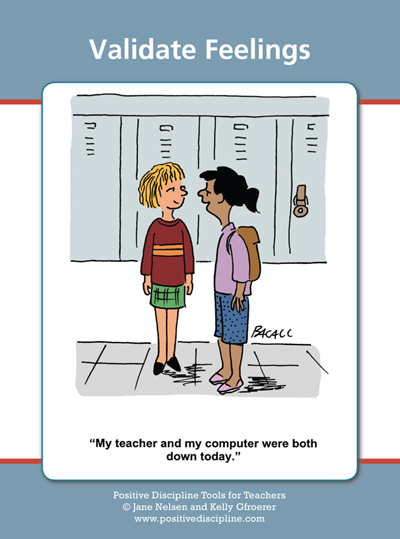by Dr. Jane Nelsen and Dr. Kelly Gfroerer

"What are you thinking?"
"I don't know."
"What are you feeling?"
"I don't know."
Does this sound familiar? In Positive Discipline we teach how important it is to understand the "belief" behind the behavior, and to "validate feelings," so we can better connect with and encourage our students, but then we hit a roadblock of "I don't knows."
The truth is that kids (and adults) often don't know the "thinking" behind their behavior, and they haven't been taught to be aware of their feelings, so they really don't know. If you are listening carefully, you can usually guess what the student is feeling. But, don’t worry about getting it right when you make guesses. Dreikurs pointed out that children will let you know if you are wrong and this opens conversation that will give you more information for how to be helpful. When you validate feelings your students know you care.
As a classroom teacher and school counselor I found that listening and validating feelings helped me learn all kinds of really helpful information that proved crucial in supporting students. Students open up and share when they know you care. By listening and validating feelings I learned what my students were thinking and feeling, and this helped me understand better how to help. For example, my first year of teaching one of my middle school students never handed in his homework. When I took just a few minutes to listen, he shared that he felt like all his parents cared about were his grades. From the moment he walked in the door in the afternoon his mom was on his case every minute about his school work. He felt like he didn’t matter to them, just his grades. He was hurting, and wanted to hurt back, so he stopped doing ANY homework. His discouragement and the purpose of his behavior were important to understand before I could help him. We met with his parents and came up with a plan that he would handle all his work independently. They made an agreement that for 3 weeks, they would not discuss homework or grades. This changed the dynamic and as a result the student started turning in homework on time. The long term result was that the student learned self-management skills, and his parents learned to quietly have faith rather than constantly tell him what to do.
Tool Tips
1. Make a guess about what the student is feeling so you can be empathic.
2. Verbalize your guess or ask: “Looks like you are really angry right now,” or “Are you feeling sad?”
3. If the student says no, guess again (so long as it is with the energy of No. 4.).
4. Be genuine, “I care about you and would like to know what is going on for you if you want to talk about it.”
5. Use your intuition about what to do next. It may tell you to offer a choice, or to ask what the student or you could do to help solve the problem. Or it may tell you to just to listen and validate feelings.
Research shows empathy is a crucial component in helping students, especially at risk students. A study conducted in urban schools examining students’ perspectives on motivation and achievement, found that teacher empathy is a key practice in promoting academic motivation and achievement. Alfred Adler defined empathy as “seeing with the eyes of another, hearing with the ears of another, and feeling with the heart of another” (Ansbaccher & Ansbacher, 1956, p. 135).

